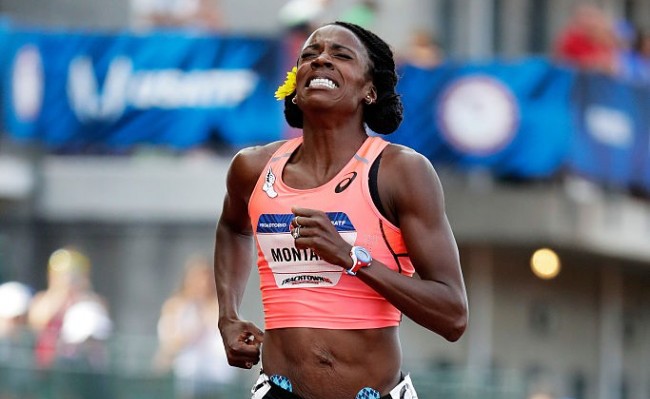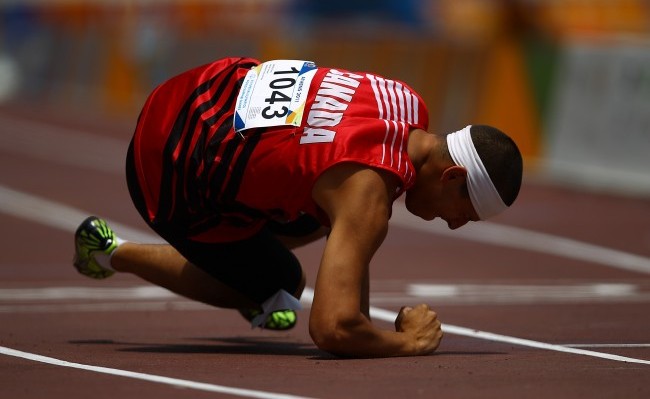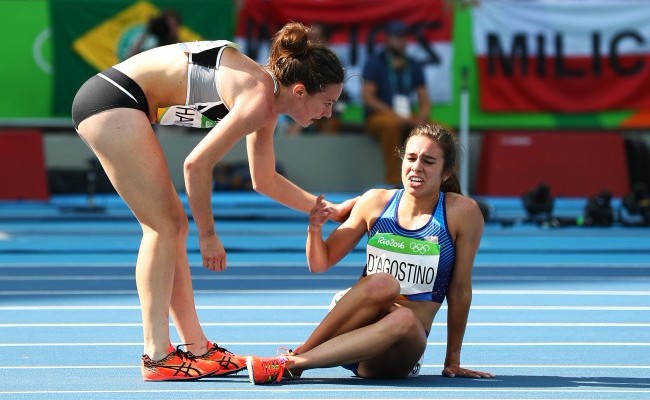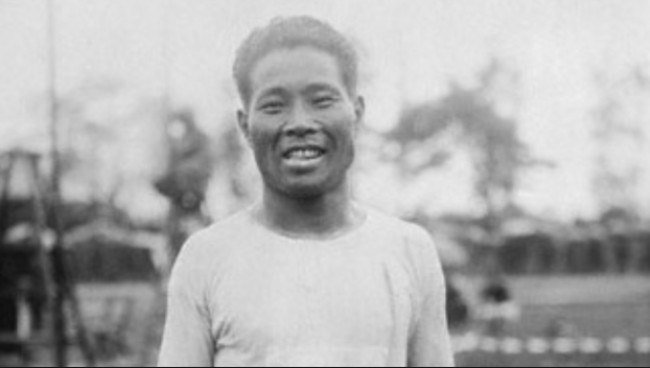
Sweat pours down your face as you squint into the sun, arms pistoning at your sides. Your legs are jelly, your breath comes in broken heaves, and you absolutely long to quit. Everything in you begs you to give up. But instead, you tell yourself to keep pushing.
You hear footsteps to your left. They’re getting louder. Hot puffs of breath sweep up from behind. A competitor is closing in. The crowd is in a frenzy — feet stamping, hands clapping, voices chanting in unison. Out of the corner of your eye you can see the other runner now, blurry and blazingly fast. Something primal rises up from deep within you. Even as tired as you are, you run faster.
Cheers erupt in the stands as the runner from behind surges forward, past you. He leaps across the finish line, arms high in victory. You, on the other hand, don’t stop to celebrate. You aren’t so showy. Besides, you realize, as you round another corner — arms still pistoning, legs plodding forward — you still have three laps to go.

As someone who has (many times) been the very last to finish a race, I know how it feels. Sure, somebody has to come last. But as the rest of the runners finish their race and you realize that you’re the only one left still running, it can feel a tad… lonely. And when your muscles refuse to fire, your cheeks are flushed and hot, and the crowd has lost interest, turning their attention to the next event and the nearest bathroom, it can start to feel like, what’s the point?
But “the point” of running is rarely about winning. It’s about pushing yourself to your limit and coming out on the other side, better for having done so. It’s about the strength and personal fortitude it takes to finish at all. It’s about the rush of endorphins that come from giving something all that you’ve got. The final finishers in a race are a testament to endurance and perseverance. They’re the ones who refused to surrender — proving the point each time they place one foot in front of the next.
The following athletes, may not have won their races — and by “not won” we mean “they came in dead last” — but they still accomplished something significant. They gave it their all and left everything they had on the track (sometimes literally). Even the most casual weekend warrior can take inspiration from these stories of last place finishers. Because when we approach every run with their enduring spirit, when we refuse to quit, we win too.
Abbey D’Agostino: The 2016 Rio Olympics

When you’ve trained your entire life as a runner, getting to the Olympics is an incredible accomplishment. But once you get there, you don’t just want to be there, you want to win. Which is why the story of the women’s 5,000-meter race in the Rio 2016 Olympics was such an extraordinary story of support and a sterling example of the best of humanity.
During the race, two runners who had never previously met — New Zealand’s Nikki Hamblin and The United States’ Abbey D’Agostino — collided. Both women tumbled to the ground. D’Agostino was up first but rather than trying to catch up to the pack, she made a split second decision to give up the race to help Hamblin to her feet.
Both women began running again, but it became clear quickly that D’Agostino was badly injured. She collapsed, and it looked like the race was over for her. This time, Hamblin stopped. She helped D’Agostino up and encouraged her to finish the race.
D’Agostino did indeed find the strength to run that final mile despite her injuries; finishing last, but triumphantly. And Hamblin was waiting to hug her when she did. It was a gesture that became absolutely emblematic of the Olympic spirit.

Derek Redmond: The 1992 Barcelona Olympics
In 1992, halfway through the men’s 400-meter race, Derek Redmond felt his hamstring snap. He collapsed. It was a devastating injury, but although medical aid came to escort him off the track, Redmond insisted on finishing.
Next, one of the sweetest things in the history of sports (and parent/child relationships) happened. Derek’s father pushed past the Olympic security and ran onto the track. He put his arm around his son and held him up. And as Redmond wept, they walked, together, over the finish line.
In the end, Redmond’s finish became the most notable in the entire event.
Maickel Melamed: The 2015 Boston Marathon
Venezuelan runner Maickel Melamed has a condition similar to muscular dystrophy. Because of this, he struggles with extremely low muscle tone — making physical tasks, even walking, incredibly difficult. Which is why it’s so very extraordinary that he’s completed five full marathons.
Melamed’s last marathon was in 2015 and every obstacle seemed stacked against him. He’d run for almost a full day and night, his legs were giving out, and he was exhausted. Then, on top of everything, it started not just raining but pouring. It was night, freezing, and he was soaked. But even with all of that, when almost anyone else would have quit, Melamed kept running. By the end of the race, he was forced to take six steps at a time, rest, and then do it again. And again, and again, until he crossed the finish line after more than 20 hours of running at 4:30 am.
It’s an unbelievable accomplishment, one that Melamed refused to accept the sole praise for, instead thanking all the people who supported him.
“It’s a message for the world,” he said. “that we can all together create amazing stuff if we work together.”
Melamed was presented his medal in a ceremony later that day and his inspiring words just kept flowing.
“In any marathon, you have to know why you’re doing it. Because in the last mile, the marathon will ask you,” he said. “For you. I run for you. I run to send a message, to raise the bar of expectation for your own self.”
This is how running elevates us, how it lifts us higher — inspiring us to “raise the bar,” as Melamed said.
Meghan Vogel: The 2012 Ohio State Track Meet
It was the high school state finals, and that was a big deal. Meghan Vogel had won an earlier race, but by the 3200-meter finals, she was exhausted. She was running well behind when rival, Arden McMath, fell and started to pass out. Vogel didn’t hesitate. She ran over to McMath and lifted her up, threw her arm over her shoulder, and took her to the finish line. She even made sure McMath finished before her.
Vogel went from first place in one race to last in the next one. But it was never a question to her to keep going once she saw McMath go down. It was beautiful moment of sportsmanship that captured hearts across the country.
Gabriela Andersen-Schiess: The 1988 Los Angeles Olympics
In 1988, women were allowed to compete in an Olympic marathon for the first time. It was historic — the first event of its kind, but also, because it was one of the most dramatic marathon finishes in modern history.
Twenty minutes after the first place winner crossed the finish line, Gabriela Anderson-Schiess of Switzerland entered the arena. And thousands of people gasped. The runner, stumbled in, one arm limp, and looked near death. A medical team rushed to try to help her but she waved them off. If they touched her, she would be disqualified. And Anderson-Schiess wasn’t going to quit.
Instead of stopping — while suffering from the heat and severe dehydration — she pushed on for over five minutes to get to the finish line. The entire world held their collective breath as she did so. Anderson-Schiess almost collapsed over and over again, but she kept running, alternatively grabbing her head and shaking, until finally limping over the finish line, where she fell into the arms of the medical personnel. It was, for anyone who watched, one of the most courageous, incredible moments they’d ever witnessed.
In an interview, twenty years after the fact, Anderson-Schiess came to terms with the fame that accompanied a finish in such a harrowing scenario. In an interview with the LA Times she speculated on why it meant so much to so many. At the end of the day, seeing her fight to complete those final feet of the race represented a never-surrender attitude that left people feeling hopeful and inspired.
“If they see that it’s not that easy but still we fight through it, even if we don’t win, it shows the spirit of the Olympics,” she said. “It’s not all about just winning.”
Evie Tate: The 2016 ACC Championship
At the ACC (Atlantic Coast Conference) Cross Country Championship in 2016, a trio of college students finished together in an inspiring show of unity and sportsmanship.
When Boston College student Madeline Adams began to fall, towards the end of the race, Evie Tate from Clemson immediately stopped running to help. This isn’t a case of, “Anyone would have done that!” Dozens of students moved past them as they struggled together towards the finish line. It was a touching moment, but one that wouldn’t have been possible if yet another student hadn’t jumped in, to aide them.
Adams couldn’t walk, and Tate, though trying, couldn’t carry her alone. That’s when Rachel Pease from Louisville decided to also forfeit her finish, in order to join Tate in helping Adams. The three women — from three different schools — all finished together and, for just a moment, they were all victorious.
John Stephen Akhwari: The 1968 Mexico City Olympics
Another story of incredible perseverance and a refusal to quit was John Stephen Akhwari. The Tanzanian runner fell during his marathon in 1968 and was badly injured — with a dislocated knee and hurt shoulder. By all accounts, he should have stopped running. But Akhwari refused all medical attention and kept going to the finish line, limping, but powering through.
Most people had left the stadium by the time he approached the finish line, those who were still there stood and screamed. It was one of the best olympic moments in history. Akhwari’s final time was 3:25:27, 19 minutes after the previous runner, but that didn’t matter. The man was clearly a champion.
When asked how he kept going through the pain, he gave a line straight out of sports movie. “My country did not send me 11,000 kilometers to start the Olympic Marathon,” he said. “They sent me here to finish it.”
Shizo Kanakuri: The 1912 Stockholm Olympics

When you’re in the middle of a marathon it can feel like getting to the finish line will take a lifetime. For most people, that’s just hyperbole born out of the exhaustion, for Shizo Kanakuri however, who finished his Olympic race for Japan 54 years, 8 months, 6 days, 5 hours, 32 minutes, and 20.3 seconds after he started, a lifetime actually did pass before his final steps.
Kanakuri, known as the father of the Japanese marathon, represented the county in the 1912 Stockholm Olympics. It was an incredibly hot day, nearly 90 degrees, and of the 67 marathon runners that day only half were able to finish the course. One even died from the heat.
Kanakuri survived, but he collapsed, and lost consciousness. Locals, who were watching the race, saw him fall, and they helped him into their home, to recover. Kanakuri was embarrassed to have not completed the run, and so he boarded a train and quietly went home without rejoining the festivities or notifying officials of his whereabouts. This was 1912, there were no helicopters following the runners. There was far less oversight on the long race that went through the countryside than there would be today.
As far as Stockholm was concerned, Kanakuri had disappeared. He didn’t just not finish the race, he was declared missing in the country, and remained so…. for 50 years.Unbeknownst to Kanakuri, he became known as the missing marathoner-a famous and mysterious story for locals.
In 1967, a journalist tracked Kanakuri down in Japan (he had continued to have a successful running career but had long since retired), and the Swedish National Olympic Committee invited him back to Sweden to come finally finish his race. Kanakuri, now elderly, accepted the invitation and according to reports happily ran the remainder of his race, his time, more than 54 years later, being read out to the crowd with the announcement that the event now officially concluded the 1912 Olympics. Though (obviously) ceremonial, the sweet gesture made him the slowest marathon runner ever.
“It was a long trip,” the then 75 year old Kanakuri said to the Swedish press of his journey to finish, “Along the way, I got married, had six children and 10 grandchildren.”
In all likelihood, none of your own runs will ever last as long as Kanakuri’s marathon. And your races won’t demand the same force of will seen in the stories above. But to love running is to love pushing your limits. Perhaps the tales related here will help you the next time you need that extra burst of fuel. Maybe they’ll help you elevate and exceed your expectations of yourself. Which is really what the whole sport is all about.






